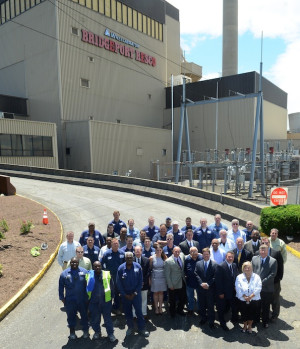As the state”™s largest waste-to-energy conversion plant marks its 25th year of operations in Bridgeport, its operators say they face increasing pressure from the rapidly expanding natural gas industry.
Wheelabrator Bridgeport L.P. processes more than 2,200 tons of waste daily ”“ generating enough energy to power the plant and more than 64,000 homes ”“ and serves about two dozen municipalities in Fairfield, Litchfield and New Haven counties. The facility is one of 17 waste-to-energy plants owned and operated by Wheelabrator Technologies Inc., which is a subsidiary of Houston-based Waste Management Inc.

“This facility here is without a doubt a regional asset,” said Vincent Langone, vice president of Wheelabrator for the New York and Connecticut region. “Typically we average 750,000 tons (processed here) on an annual basis. I don”™t know of any other technologies out there that can handle volumes of that magnitude.”
However, Langone said the company has felt the impacts of the rush of cheap natural gas to the marketplace.
For its first 20 years of operation, Wheelabrator Bridgeport operated under a power purchase agreement with United Illuminating (UI) Co., by which it would sell any power it generated to UI under contracted rates. Since that agreement expired at the end of 2008, the Bridgeport facility has sold its power on the day-ahead market based on the daily market price per kilowatt hour.
“The fact that some of our waste-to-energy facilities have rolled off of their 20-year power purchase agreements, and with natural gas prices being as low as they are today, it”™s affected the energy markets accordingly,” Langone said. “That being the case, we have realized a substantial decrease in energy revenue. The past couple years haven”™t been as good to the company from a profitability standpoint.”
Additionally, Langone said the facility competes with out-of-state landfills that jockey for Connecticut towns”™ waste. Connecticut itself does not have any municipal solid waste landfills.
“We are in competition with some of the bigger landfills from a disposal pricing standpoint,” he said. He said the bigger landfills can lower their disposal prices, which in turn makes it easier for trash haulers to deposit their refuse there. “It”™s not just us, but any waste-to-energy company out there is in the same situation.”
The facility generates energy by processing waste through a utility-grade boiler and by transforming the chemical energy in the waste to thermal energy, which in turn generates turbines that produce electricity.
Langone said Wheelabrator Bridgeport adheres to the “strictest EPA and local regulatory agency guidelines.”
“Over the course of the last 10 or 15 years with the changes in the air standards, we”™ve been required to upgrade our emissions system accordingly,” Langone said. “So we”™re considered one of the cleanest technologies out there.”
Langone, who previously served as facilities manager of Wheelabrator Bridgeport, said the company has enjoyed strong ties with the city of Bridgeport. “We”™ve been here 25 years working hand-in-hand with the city, and we”™ve had a very good relationship with the city over that period.”
















Any efforts to boost the supplies of wood-wastes to fuel waste-to-energy facilities?
Supplementing wood wastes such as construction wastes e.g., including processed woods such as particle-board, and press-board with garbage incineration can offer such advantages as:
* Greater energy efficiencies than garbage alone.
* Wood-wastes are easier to transport, process, and handle than garbage.
* Wood burns cleaner than most types of garbage.
Reassessing the supply-chains of wood-wastes can include importation of wood-wastes from as far away as the West Coast e.g., as the quantities of wood-wastes from California can make importation an economically favorable option esp. wood-wastes containing low-moisture content, as drought conditions continue on the West Coast.
RELATED:
Imagine; Sweden must import trash for their ‘waste to energy facilities’ because their recycling programs are so successful! Story LINK: http://goo.gl/ks4Ec
Will Sweden ever import wood-wastes from North America?
Michael